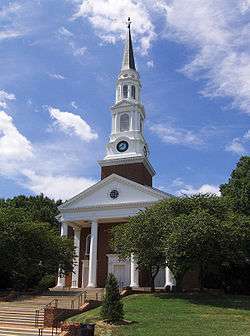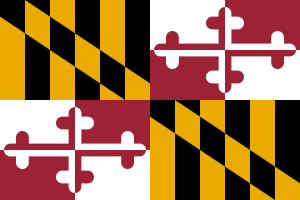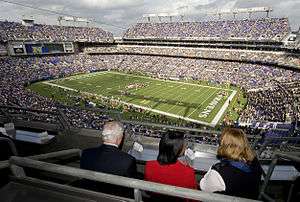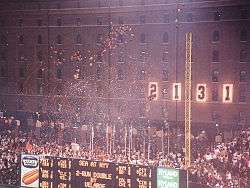Maryland Terrapins
The Maryland Terrapins, commonly referred to as the Terps, consist of 19 men's and women's athletic teams that represent the University of Maryland, College Park in National Collegiate Athletic Association (NCAA) Division I competition. Maryland was a founding member of the Southern Conference in 1921, a founding member of the Atlantic Coast Conference in 1952, and is now a member of the Big Ten Conference.
| Maryland Terrapins | |
|---|---|
 | |
| University | University of Maryland |
| Conference | Big Ten Conference |
| NCAA | Division I/FBS |
| Athletic director | Damon Evans |
| Location | College Park, Maryland |
| Varsity teams | 19 |
| Football stadium | Maryland Stadium |
| Basketball arena | XFINITY Center |
| Baseball stadium | Bob "Turtle" Smith Stadium |
| Soccer stadium | Ludwig Field |
| Lacrosse stadium | Maryland Stadium |
| Other arenas | Cole Field House |
| Mascot | Testudo |
| Nickname | Terps |
| Fight song | "Fight, Fight, Fight for Maryland!", "Maryland Victory Song" |
| Colors | Red, White, Black, and Gold[1] |
| Website | umterps |

The nickname was coined in 1932 by Harry C. "Curley" Byrd, then the school's football coach and later the school's president. Previously, Maryland teams were known as the "Old Liners"—a reference to the state's nickname, "The Old Line State." However, the school newspaper, The Diamondback, wanted a better nickname. Byrd thought "Terrapins" was a good choice because of the diamondback terrapins endemic to the Chesapeake Bay region. Byrd's hometown of Crisfield was famous for the number of terrapins along its shores.[2] The school mascot is an anthropomorphic turtle named "Testudo." The official team colors are red, white, black, and gold, derived from the Maryland state flag.[3] It is the only NCAA school to have four official school colors.[4] On July 1, 2014, the Terrapins became members of the Big Ten Conference following 62 years of membership in the Atlantic Coast Conference.[5] The university currently sponsors varsity athletic teams in 20 men's and women's sports, which compete at the NCAA Division I level.
History
The University of Maryland, College Park was established in 1856 as Maryland Agricultural College. Baseball and football were played on the campus as early as the Civil War era.[6] It was renamed Maryland State College in 1916, and in 1920, merged with the state's professional schools in Baltimore to become the University of Maryland. Between 1921 and 1953, the university was a member of the Southern Conference.
Longstanding tensions within the Southern Conference culminated in 1951, when it passed a ban on participation in bowl games midway through the football season. At the end of the regular season, both Maryland and Clemson were invited and accepted invitations to postseason bowl games. The Southern Conference sanctioned the two schools with a one-year probation in which they could not schedule any football games against conference opponents.[7] On May 8, 1953, Maryland became a founding member of the Atlantic Coast Conference (ACC) when it and six other schools voted to split from the Southern Conference.[8][9]
As a result of a committee's recommendation to cut athletics costs, funding for eight teams was eliminated on November 21, 2011, a move supported by University President Wallace Loh. However, the president also showed support for a "Save the Programs Campaign", which gave the teams a chance to raise eight years of total program costs by June 30, 2012. The affected teams were men's cross country, indoor track, and outdoor track, men's swimming and diving, men's tennis, women's acrobatics and tumbling, women's swimming and diving, and women's water polo. On July 1, 2012, the University officially cut seven of those teams. The men's outdoor track team raised $888,000 of a target amount of $940,000, which was deemed sufficient to avoid elimination.[10]
On November 19, 2012, the University of Maryland's Board of Regents voted to withdraw from the ACC to join the Big Ten Conference effective July 1, 2014.[11]
Sports sponsored
| Men's sports | Women's sports |
|---|---|
| Baseball | Basketball |
| Basketball | Cross country |
| Football | Field hockey |
| Golf | Golf |
| Lacrosse | Gymnastics |
| Soccer | Lacrosse |
| Track & field | Soccer |
| Wrestling | Softball |
| Tennis | |
| Track & field† | |
| Volleyball | |
| † – Track and field includes both indoor and outdoor. | |
The University of Maryland currently offers 20 varsity teams: 8 men's and 12 women's.
Baseball
- NCAA Tournament Regional Champions: 2014, 2015
- NCAA Tournament Appearances: 1965, 1970, 1971, 2014, 2015, 2017
- Conference Champions: 1936, 1965, 1970, 1971
- Conference Tournament Champions: None
Men's basketball
Burton Shipley was Maryland's first and longest serving basketball coach, but his lengthy tenure from 1923 to 1947 was described as "remarkably quiet".[12] At that time, the sport was not widely popular in the mid-Atlantic region and football and boxing were much better drawing spectator sports on the Maryland campus. To capitalize on the popularity, basketball games at Ritchie Coliseum were held as doubleheaders with boxing matches for 26 years.[13] Bud Millikan became head coach in 1950 and soon led Maryland to consistent respectability within the Southern Conference.[14] Defensive point guard Gene Shue averaged 22 points per game and his scoring record stood for two decades.[15] In 1955, the small Ritchie Coliseum was replaced by ; games were moved to the larger Cole Field House, centrally located on campus, and when Maryland became a member of the Atlantic Coast Conference (ACC), the fanbase rapidly expanded.[16] Millikan's tenure culminated in 1958 when Maryland won its first Atlantic Coast Conference tournament championship and advanced to the Elite Eight in the NCAA Tournament.
In 1969, Lefty Driesell was hired by the University of Maryland. Drisell led the Terrapins to eight NCAA Tournament appearances, a National Invitation Tournament championship, two Atlantic Coast Conference regular-season championships, and one Atlantic Coast Conference tournament championship.[17] Maryland also attained a No. 2 Associated Press ranking during four consecutive seasons from 1972 to 1976.[17]
Driesell coached the Maryland Terrapins from 1969 to 1986. During his tenure, he successfully recruited numerous exceptional players, including Tom McMillen, Len Elmore, John Lucas, Albert King, Buck Williams, and Len Bias.[18]
At Maryland, Driesell began the now nationwide tradition of Midnight Madness. According to longstanding NCAA rules, college basketball teams were not permitted to begin practices until October 15. Driesell traditionally began the first practice with a requirement that his players run one mile in six minutes, but found that the players were too fatigued to practice effectively immediately afterwards. At 12:03 a.m. on October 15, 1971, Driesell held a one-mile run at the track around Byrd Stadium, where a crowd of 1,000 fans had gathered after learning of the unorthodox practice session. The event soon became a tradition to build excitement for the basketball team's upcoming season.[19] Midnight Madness has been adopted by many national programs such as UNC, Kansas, Kentucky, Michigan State and Duke.[20][21][22][23]
In 1972, Maryland defeated Niagara, 100–69, to secure the National Invitation Tournament championship. Driesell said that the season attained the three goals he had set for the program at the time of his hiring: "national prominence", "national ranking", and "a national championship".[24]
In the 1974 ACC Men's Basketball Tournament, Maryland was defeated by North Carolina State University in overtime, 103–100. Many consider it to be one of the greatest college basketball games of all time.[25][26][27][28] North Carolina State University eventually went on to win the 1974 National Championship. Maryland finished No. 4 in the final Associated Press poll that season, prompting the NCAA to make a landmark decision in 1975. The NCAA tournament committee expanded the field from 32 to 48 teams, which opened the door for more than one team from a conference.[29]
In 1984, Driesell led the team to the school's second ACC Tournament Championship.[30] In December 1985, the university gave Driesell a ten-year contract extension. Earlier that same year, Driesell was made an Honorary M Club member. He ended his career at Maryland with a 348–159 overall record. His winning percentage of .686 is the best ever for a Maryland coach.
Gary Williams became head coach in 1989, bringing Maryland back to national prominence following difficult years. By March 2010, Williams was the fifth-winningest active coach in the country and the third-winningest coach all-time in the ACC (behind only Dean Smith and Mike Krzyzewski). In 2002, Williams led the Terrapins to the program's first national championship, defeating Indiana, 64–52. Williams retired in May 2011 and Mark Turgeon was hired from Texas A&M to be his successor.
- NCAA National Champions: 2002
- NCAA Final Fours: 2001, 2002
- NCAA Tournament appearances: 1958, 1973, 1975, 1980, 1981, 1983 - 1986, 1994 - 2004, 2007, 2009, 2010, 2015, 2016, 2017
- Conference Champions: 1932, 1975, 1980, 1995, 2002, 2010, 2020
- Conference Tournament Champions: 1931, 1958, 1984, 2004
Women's basketball
- NCAA National Champions: 2006
- NCAA/AIAW Final Fours: 1978, 1982, 1989, 2006, 2014, 2015
- NCAA/AIAW Tournament Appearances: 1978 - 1984, 1986, 1988 - 1993, 1997, 2001, 2004 - 2009, 2011 - 2020
- Conference Champions: 1979, 1982, 1988, 1989, 2009, 2015 - 2017, 2019, 2020
- Conference Tournament Champions: 1978, 1979, 1981 - 1983, 1986, 1988, 1989, 2009, 2012, 2015 - 2017, 2020
Field hockey
- NCAA National Champions: 1987, 1993, 1999, 2005, 2006, 2008, 2010, 2011
- NCAA Final Fours: 1987, 1991, 1993, 1995, 1999 - 2001, 2003 - 2006, 2008 - 2013, 2017, 2018
- NCAA Tournament Appearances: 1978 - 1984, 1986, 1988 - 1993, 1997, 2001, 2004 - 2018
- Conference Champions: 1992, 1998 - 2000, 2005, 2008 - 2010, 2013 - 2016, 2018
Football
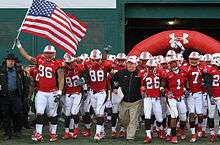
An unofficial football team composed of Maryland Agricultural College students played games against local high schools in 1890 and 1891. The following year, the school lent its support, which marked the official establishment of the Maryland football program in 1892. The football team has continued to the present day with the exception of a brief hiatus in 1895. In 1894, former Maryland coach and player William W. Skinner spearheaded the formation of the Maryland Intercollegiate Football Association, which served to award the state football championship.[31] Maryland hired D. John Markey as its first paid football coach in 1902.[32] H. C. "Curley" Byrd, who eventually served as the university president from 1936 to 1953,[33] began his playing career on the team in 1905.[34] In 1911, Byrd was appointed as the head football coach, and he served in that position through 1934. During his tenure, Byrd was instrumental in growing support of the program, and in 1915 successfully requisitioned funding for the school's first stadium.[35] In his position as university president, he was also responsible for building the school's current football facility, Maryland Stadium.
In 1945, Paul "Bear" Bryant began his long and distinguished career as a head football coach at the University of Maryland.[36] The following year, he was replaced by Jim Tatum, a pioneer of the split T. Maryland football achieved its greatest success under Tatum, who compiled a 73–15–4 record without a single losing season, and to date, he remains the winningest Maryland coach of the modern era.[37] NCAA recognized selectors awarded Maryland the national football championship in 1951 and 1953.[38] During Tatum's tenure from 1946 to 1955, Maryland also secured one Southern Conference championship and two Atlantic Coast Conference championships.[37] In 1962, Darryl Hill transferred to Maryland from the United States Naval Academy, making the school the first team in the Atlantic Coast Conference with a black player.[39] Jerry Claiborne became head coach in 1972, and led Maryland to three consecutive ACC championships from 1974 to 1976. The Terrapins finished the 1976 regular season with an undefeated 11–0 record, but lost to Houston in the Cotton Bowl Classic, which ended national championship speculation.[40] Bobby Ross replaced Claiborne in 1982, and he repeated the feat of three consecutive ACC championships from 1983 to 1985. In 1984, Maryland quarterback Frank Reich led the Terrapins to the then greatest halftime comeback against the defending national champions, Miami.[41] After a long bowl game drought, Ralph Friedgen was hired as head coach in 2001, and in his first season, led Maryland to the ACC championship and its first Bowl Championship Series game appearance.[42]
The football program has secured two NCAA-recognized national championships, nine ACC championships, two Southern Conference championships, eleven consensus All-America honors, and twenty-four bowl game appearances. Maryland possesses the third-most ACC championships with nine, which places them behind Clemson (13) and Florida State (12). Many former Terrapins players and coaches have gone on to careers in professional football including 15 first-round NFL Draft picks.[37]
- National Champions: 1951, 1953
- Undefeated Regular Seasons: 1893, 1951, 1953, 1955, 1976
- Conference Champions: 1937, 1951, 1953, 1955, 1974 - 1976, 1983 - 1985, 2001
- Bowl Appearances: 1947, 1949, 1951, 1953, 1955, 1973 - 1978, 1980, 1982 - 1985, 1990, 2001 - 2003, 2006 - 2008, 2010, 2013, 2014, 2016
Men's lacrosse
The Terrapins men's lacrosse team is one of the most tradition-rich in all of collegiate lacrosse, having advanced to 14 NCAA Championship games since its inception in 1971, winning the title in 1973, 1975, and 2017. The Terrapins' lacrosse tradition traces back even further with eight Wingate Memorial Trophies between 1936 and 1970. As members of the Atlantic Coast Conference, the school won a record league-record 25 championships. Since joining the Big Ten Conference in 2014, Maryland has won four Big Ten championships and two Big Ten tournament championships.
- National Champions: 1928, 1936–37, 1939–40, 1955–56, 1959, 1967, 1973, 1975, 2017
- NCAA Finals: 1971, 1973–76, 1979, 1995, 1997–98, 2011–12, 2015–17
- NCAA Final Fours: 1971–79, 1983, 1987, 1989, 1991, 1995, 1997–98, 2003, 2005–06, 2011–12, 2014-2018
- NCAA Tournament Appearances: 1971–76, 1978–79, 1981–83, 1986–87, 1989, 1991–98, 2000–01, 2003-18
- Conference Champions: 1957–61, 1963, 1965–68, 1972–74, 1976–80, 1985, 1987, 1989, 1998, 2001, 2003–04, 2009, 2013–18
- Conference Tournament Champions: 1998, 2004–05, 2011, 2016–17
Women's lacrosse
- National Champions: 1981, 1986, 1992, 1995–2001, 2010, 2014, 2015, 2017, 2019
- NCAA Final Fours: 1984–1986, 1990–2001, 2003, 2009-2019
- NCAA Tournament Appearances: 1983–1987, 1990-2019
- Conference Champions: 1997, 1999, 2001, 2003, 2007–2011, 2013-2019
- Conference Tournament Champions: 1997, 1999–2001, 2003, 2009–2014, 2016–18
Men's soccer
- NCAA National Champions: 1968, 2005, 2008, 2018
- NCAA College Cups: 1960, 1962, 1963, 1968, 1969, 1998, 2002 - 2005, 2008, 2012, 2013, 2018
- NCAA Tournament Appearances: 1959 - 1964, 1967 - 1971, 1973, 1976, 1986, 1994 - 1999, 2001 - 2018
- Conference Champions: 1949 - 1951, 1953 - 1968, 1971, 2012 - 2014, 2016
- Conference Tournament Champions: 1996, 2002, 2008, 2010, 2012 - 2016
Softball
The Terrapins softball team began play in 1995. The team has made four NCAA Tournament appearances in 1999, 2010, 2011, and 2012. The current head coach is Julie Wright.
Wrestling
Prior to joining the Big Ten in 2014, the Terrapins wrestling team won more ACC team championships than any other school in the conference, winning their 24th ACC title in 2012. The 2012 ACC championship is the Terps' fourth in the past five years. Maryland has finished in the top 20 at the NCAA Championships each year since the 2010 season and produced multiple all Americans since 2009, a school record. Two-time NCAA champion and two-time Olympian Kerry McCoy was head coach for eleven years until 2019. The XFINITY Center is the arena for the Terrapin Wrestling team.[43]
Maryland has had over 200 ACC Champions, 2 NCAA Champions, and 18 NCAA all Americans. In 2010 Hudson Taylor became Maryland's first three-time all American with his fourth-place finish at 197 pounds. Spencer Myers became Maryland's first freshman in 2011 when he earned all American status with his sixth-place finish at heavyweight. The first wrestling team started in 1940 competed in the Southern Conference, with Paul McNeil becoming the Terps' first champion that same year at 175 pounds.[44] In 2014, Jimmy Sheptock had one of the greatest runs in Maryland wrestling history, with a 32–1 record, ACC Championship, and the first Maryland wrestler to obtain a number one seed at the NCAA Championships, where he was runner-up to Ed Ruth.
The Maryland wrestling team was dominant in the ACC throughout the 1950s and 1960s and returned to claim two more conference titles in the late 2000s.[45] However, in its first season in the Big Ten, Maryland failed to win a Big Ten dual meet. After 13 tries, Maryland finally won its first Big Ten dual meet January 10, 2016, against perennial conference cellar-dweller Michigan State.
In April 2019, former Edinboro wrestler and Missouri assistant Alex Clemsen was named head coach.
Notable non-varsity sports
Figure skating
The Maryland Figure Skating Club began at UMD in 2004 and became a club sport in 2007. The club comprises three teams: a freestyle team and two synchronized skating teams. All teams compete in and out of region through the United States Figure Skating Association.[46] The Maryland Terrapins Black are the reigning 2018 Eastern Sectional Champions in the Open Collegiate division
Skaters from across the three teams have, by invitation, performed demonstrations for a variety of publications, most recently being featured in the Washington Post: ter.ps/FigSkateWaPo.
Rugby
The Maryland Terrapins rugby team was founded in 1968. Maryland's best season was 1985, when Maryland played in the national championship final, losing 31–6 to Cal. (See National Collegiate Rugby Championship results.) Maryland plays in the Atlantic Coast Rugby League, a conference formed in 2011 along with other Atlantic Coast Conference schools. The Terps are led by head coach Jeff Soeken, who was a three-time All-American when he played rugby for Maryland.[47]
Maryland was the champion of the league's inaugural 2011 season, defeating North Carolina, 39–32, in the title match.[48] Maryland repeated as Atlantic Coast champion again in 2012, defeating Clemson. Maryland placed 10th in the 2012 Collegiate Rugby Championship (CRC), notching wins against Penn State and Oklahoma.[49] The CRC is the highest-profile college rugby tournament in the country, held at PPL Park in Philadelphia and broadcast live on NBC.[50] Maryland reached the semifinals of the 2012 ACI 7s tournament in Blacksburg.[51]
Traditions
Rivalries
Songs and chants
Victory Song The Maryland Victory Song was written in 1928 by Thornton W. Allen. It is played frequently during Terp Basketball and Football games. During Football games, it is played after every touchdown the Terps score, regardless of whether the team is winning or losing, celebrating the immediate victory of accomplishment. Ironically, the "Victory" song is played even after defeat.
During the M-A-R-Y-L-A-N-D section of the victory song, Terrapins fans show their clenched fists, and alternate pumping them in the air, beginning with their right fist on the "M" and alternating between left and right with each letter of the MARYLAND. The motion resembles someone climbing a ladder.[52]
Alma Mater & Fight Song Other official school songs include the school's Alma Mater and Fight Song. Each of these are played at every home football game during the pregame festivities.[53]
"Hey, You Suck!" A popular saying among the students at Maryland is a simple "Hey, You Suck!" directed at opponents. Students have incorporated the phrase into Gary Glitter's popular sports anthem "Rock and Roll Part Two" (often referred to as the "Hey Song"). Sometime in the early 2000s, then-football coach Ralph Friedgen asked that the song not be played at football games. Friedgen had never liked hearing the song since his return to College Park in 2001, and added that it hurt his recruiting efforts.[54] In 2004, basketball coach Gary Williams followed Friedgen's lead and asked that the song not be played at basketball games either. While he personally liked the song, complaints from a large number of parents and grandparents had led him to conclude it was too controversial.[55] However, the students have continued to sing the song without the band's support. Before each basketball game and after every touchdown at football games, the crowd sings the song a cappella. An alternative version, which grew out of the Duke-Maryland basketball rivalry, replaces the phrase "You Suck" with "Fuck Duke." Students would often use the alternate phrase during games against teams other than Duke and have continued the tradition in the Big Ten Conference, even though the school no longer plays Duke.
Football and basketball
Key Plays At football games, Terp fans also shake their keys to signify urgency ("Key" Plays).[52]
Fist Pump At the beginning of each men's basketball game during his tenure, Maryland Coach Gary Williams would pump his fist to signify a good game.[52]
Midnight Madness Midnight Madness was originally started by Maryland Head Coach Lefty Driesell in 1970. Midnight Madness is held at the earliest time the Men's Basketball Team can practice, which used to be midnight on the first day of practice. Students would attend the practice and over the years it has evolved into a circus-like atmosphere, including light shows, magic shows, the mascot trampoline challenge, skits, food, beverage, and other fanfare.
Recently, Maryland and some other schools have moved the start of Midnight Madness to earlier in the day - generally around 7 o'clock - with permission of the NCAA. This is to encourage more families and fans who aren't even students to attend the event. As a result of this change, Midnight Madness has been rebranded as "Maryland Madness".[52]
Newspaper Shaking Maryland students attempt to read the newspaper as the opposing team is being introduced. They shake the paper as the visiting team is introduced.[52]
Other sport traditions
The Crew The Crew is a group of men's soccer fans. They generally sit behind the goal the opposing team is defending (switching sides at halftime) and berate the opposing goalie, referring to him by formal (given) name. Members of the Crew often travel to away games to continue to support their Terps. The Crew also organize activities to join the soccer environment.[52]
The "Turgeonites" The Turgeonites are a group of students who dress in a suit and tie with a gray streak through their hair emulating head men's basketball coach Mark Turgeon. They can be seen in the student section behind the Maryland bench during every home game.
Championships
NCAA team championships
The University of Maryland has won 31 NCAA team national championships, 26 while a member of the Atlantic Coast Conference.[56]
- Men's (8)
- Basketball (1): 2002
- Lacrosse (3): 1973, 1975, 2017
- Soccer (4): 1968 (co-champions), 2005, 2008, 2018
- Women's (23)
- Basketball (1): 2006
- Field Hockey (8): 1987, 1993, 1999, 2005, 2006, 2008, 2010, 2011
- Lacrosse (14): 1986, 1992, 1995, 1996, 1997, 1998, 1999, 2000, 2001, 2010, 2014, 2015, 2017, 2019
- See also:
Other national team championships
Below are 23 national team titles that were not bestowed by the NCAA:
Hall of fame
Maryland Sports Radio Network
| City | Call Sign | Frequency |
|---|---|---|
| Baltimore, Maryland | WJZ-AM | 1300 AM |
| Baltimore, Maryland | WJZ-FM | 105.7 FM |
| Cambridge, Maryland | WCEM-AM | 1240 AM |
| Cumberland, Maryland | WCMD-AM | 1230 AM |
| Frederick, Maryland | WFMD-AM | 930 AM |
| Hagerstown, Maryland | WARK-AM | 1490 AM |
| Lexington Park, Maryland | WPTX-AM | 1690 AM |
| Oakland, Maryland | WMSG-AM | 1050 AM |
| Pocomoke City, Maryland | WGOP-AM | 540 AM |
| Pocomoke City, Maryland | WGOP-FM | 100.7 FM |
| Pocomoke City, Maryland | WBEY-FM | 97.9 FM |
| Prince Frederick, Maryland | WDCJ | 92.7 FM |
| Salisbury, Maryland | WTGM-AM | 960 AM |
| Washington, D.C. | WTEM-AM | 980 AM |
References
- "Logos and Brand Standards: Office of Trademarks and Licensing". Retrieved April 29, 2020.
- "Testudo: Tale of the Top Shell". Maryland Terrapins. April 4, 2013. Retrieved July 13, 2018.
- "School Colors". Maryland Terrapins. July 7, 2018. Retrieved July 13, 2018.
- Sandys, Toni (February 10, 2008). "After Losing Black Jerseys, Terrapins Go for the Gold". Washington Post. ISSN 0190-8286. Retrieved April 24, 2020.
- "University of Maryland and Rutgers University Become Official Members of Big Ten Conference" (Press release). Big Ten Conference. July 1, 2014. Archived from the original on June 26, 2016. Retrieved January 25, 2017.
- David Ungrady, Tales from the Maryland Terrapins, 2003, pp. 3–4, Sports Publishing LLC.
- K. Adam Powell, Border Wars: The First Fifty Years of Atlantic Coast Conference Football, p. xvi, Scarecrow Press, 2004, ISBN 0-8108-4839-2.
- Seven Major Dixie Colleges Break Away From Bulky Southern Conference, Sarasota Herald-Tribune, May 9, 1953.
- Seven Southern Colleges Join New Athletic League, The Hartford Courant, June 15, 1953.
- "University of Maryland cuts 7 sports teams, saves men's outdoor track". si.com. Archived from the original on December 25, 2012. Retrieved October 5, 2012.
- Prewitt, Alex (November 19, 2012). "Maryland moving to Big Ten". The Washington Post. Retrieved November 19, 2012.
- Paul McMullen, Maryland Basketball: Tales from Cole Field House, p. 2, JHU Press, 2002, ISBN 0-8018-7221-9.
- Johnny Holliday, Stephen Moore, John Feinstein, Hoops Tales: Maryland Terrapins Men's Basketball, p. 149, Globe Pequot, 2006, ISBN 0-7627-3990-8.
- Ungrady, p. 82.
- Catching Up With ... former Bullet Gene Shue, The Baltimore Sun, December 3, 2009.
- Holliday et al, p. 151.
- Lefty Driesell Coaching Record, Sports Reference, retrieved June 8, 2011.
- Milestones in Driesell's Career, The Washington Post, October 30, 1986.
- He made midnight a time for madness; The college basketball tradition that resumes tonight began in 1971 with Maryland's Lefty Driesell, St. Petersburg Times, October 13, 2006.
- Davis, Seth. "The story how Lefty Driesell started Midnight Madness at Maryland". SI.com. Retrieved May 23, 2017.
- "College basketball: Midnight Madness 2016 times and dates". NCAA.com. October 20, 2016. Retrieved May 23, 2017.
- "Midnight Madness: MSU's Tom Izzo trades in HOF jacket for 'lab coat'". Detroit Free Press. Retrieved May 23, 2017.
- "College basketball: UNC, Kentucky kick off seasons with Midnight Madness-style events". NCAA.com. October 14, 2016. Retrieved May 23, 2017.
- Terps attain two of their three goals set by coach Driesell, The Free Lance-Star, March 27, 1972.
- "Classic 1974 NC State-Maryland ACC title clash hits 40-year mark | FOX Sports". FOX Sports. March 12, 2014. Retrieved May 23, 2017.
- "The Greatest College Basketball Game Ever Played". home.earthlink.net. Archived from the original on May 2, 2016. Retrieved May 23, 2017.
- StateFans (March 9, 2009). "35th Anniversary of Greatest College Game Ever Played". StateFans Nation. Retrieved May 23, 2017.
- "40 Years Later, It Might Still Be Best College Hoops Game Played". Retrieved May 23, 2017.
- "This overtime lasts 25 years". tribunedigital-baltimoresun. Retrieved May 23, 2017.
- Driesell Keeps Perspective, Star-News, March 10, 1984.
- Ungrady, pp. 4–6.
- Ungrady, p. 10.
- Harry Clifton Byrd papers Archived June 23, 2012, at Archive-It, University of Maryland Libraries, retrieved July 4, 2010.
- Ungrady, p. 15.
- Ungrady, p. 24.
- Football's Supercoach, Time, September 29, 1980.
- Year-by-Year Results Archived June 17, 2009, at WebCite (PDF), 2008 Maryland Football Media Guide, University of Maryland, 2008.
- Past Division I Football Bowl Subdivision (Division I FBS) National Champions, National Collegiate Athletic Association, retrieved December 1, 2008.
- Tom D'Angelo, Barriers made to be broken The Palm Beach Post, October 25, 2006.
- Cotton Bowl Foes Arrive, The New York Times, December 27, 1976.
- This Day in History November 10, 1984: Maryland gets a miracle in Miami Archived February 11, 2010, at the Wayback Machine, The History Channel, retrieved September 6, 2009.
- Terps Bowled Over by Gators; Maryland's Uplifting Season Ends With Orange Bowl Defeat, 56-23, The Washington Post, p. A01, January 3, 2002.
- "Terrapin Wrestling Information". University of Maryland Athletics. Retrieved 2014. Check date values in:
|accessdate=(help) - Kyle John celebrates his 157 pound 2012 ACC title
- "Maryland Athletics – University of Maryland Official Athletic Site – Wrestling". Umterps.com. Archived from the original on March 29, 2012. Retrieved April 23, 2012.
- "Maryland Figure Skating Club". umd.orgsync.com. Retrieved October 30, 2017.
- Maryland Rugby
- The Atlantic Coast Rugby League, 2011 All ACRL Teams announced, April 21, 2011
- Rugby Mag, Tanifum Steals the Show at CRC, June 6, 2012, "Archived copy". Archived from the original on September 23, 2012. Retrieved June 7, 2012.CS1 maint: archived copy as title (link)
- "15 Teams Invited to 2012 CRC, November 3, 2011". RugbyMag.com. Retrieved January 16, 2018.
- "Virginia Tech Wins ACI Opener, September 13, 2012". RugbyMag.com. Archived from the original on September 24, 2012. Retrieved January 16, 2018.
- "Athletic Traditions". University of Maryland. Archived from the original on August 20, 2010. Retrieved September 8, 2010.
- "Traditional Songs". University of Maryland. Archived from the original on December 4, 2010. Retrieved September 8, 2010.
- Justin Fenton (September 30, 2004). "Maryland Sportsmanship Committee Reverses Decision". The Diamondback.
- Justin Fenton (October 1, 2004). "And The Band Didn't Play On". The Diamondback.
- http://fs.ncaa.org/Docs/stats/champs_records_book/Overall.pdf
- "FBS Football". NCAA.com. Retrieved October 30, 2017.
- Scott, Bob (1976). Lacrosse Technique and Tradition. The Johns Hopkins University Press. ISBN 0-8018-2060-X.
External links
| Wikimedia Commons has media related to University of Maryland athletics. |
